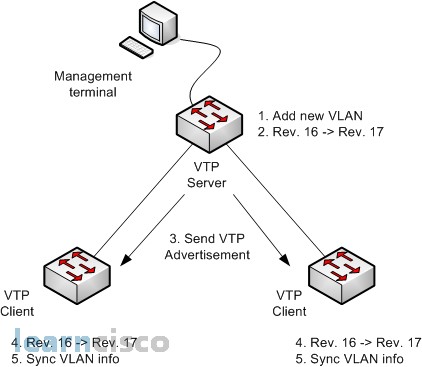Cisco switches use the proprietary VTP to exchange VLAN configuration information between switches. VTP defines a Layer 2 messaging protocol that allows the switches to exchange VLAN configuration information so that the VLAN configuration stays consistent throughout a network. For instance, if you want to use VLAN 3 and name it “accounting,” you can configure that information in one switch, and VTP will distribute that information to the rest of the switches. VTP manages the additions, deletions, and name changes of VLANs across multiple switches, minimizing misconfigurations and configuration inconsistencies that can cause problems, such as duplicate VLAN names or incorrect VLANtype settings.
VTP makes VLAN configuration easier. However, you have not yet seen how to configure VLANs, so to better appreciate VTP, consider this example: If a network has ten interconnected switches, and parts of VLAN 3 were on all ten switches, you would have to enter the same config command on all ten switches to create the VLAN. With VTP, you would create VLAN 3 on one switch, and the other nine switches would learn about VLAN 3 dynamically.
The VTP process begins with VLAN creation on a switch called a VTP server. The changes are distributed as a broadcast throughout the network. Both VTP clients and servers hear the VTP messages and update their configuration based on those messages. So VTP allows switched network solutions to scale to large sizes by reducing the manual configuration needs in the network.
How it works
VTP floods advertisements throughout the VTP domain every 5 minutes, or whenever there is a change in VLAN configuration. The VTP advertisement includes a configuration revision number, VLAN names and numbers, and information about which switches have ports assigned to each VLAN. By configuring the details on one (or more) VTP server and propagating the information through advertisements, all switches know the names and numbers of all VLANs.
One of the most important components of the VTP advertisements is the configuration revision number. Each time a VTP server modifies its VLAN information, it increments the configuration revision number by 1. The VTP server then sends out a VTP advertisement that includes the new configuration revision number. When a switch receives a VTP advertisement with a larger configuration revision number, it updates its VLAN configuration. The following scheme illustrates how VTP operates in a switched network.

VTP operates in one of three modes:
- Server mode
- Client mode
- Transparent mode
For VTP to exchange information, some switches act as servers, and some act as clients. VTP servers can create, modify, and delete VLANs and other configuration parameters for the entire VTP domain; this information, in turn, is propagated to the VTP clients and servers in that same domain. VTP servers save VLAN configurations in the Catalyst NVRAM, whereas in clients, the VLAN configuration is not stored at all. A VTP client cannot create, change, or delete VLANs, nor can it save VLAN configurations in nonvolatile memory.
To avoid using VTP to exchange VLAN information in Cisco switches, you use VTP transparent mode. With VTP transparent mode on all switches in a network, VTP is not used. Alternatively, with VTP transparent mode on just some of the switches in a network, VTP servers and clients can work as they normally do, and the VTP transparent mode switches simply ignore the VTP messages. A switch in transparent mode forwards VTP advertisements received from other switches while ignoring the information in the VTP message.
A switch configured in VTP transparent mode can create, delete, and modify VLANs, but the changes are not transmitted to other switches in the domain; they affect only that switch. Choosing to use transparent mode is typical when a network needs to distribute administrative control of the switches. A switch configured in VTP transparent mode can create, delete, and modify VLANs, but the changes are not transmitted to other switches in the domain; they affect only that switch. Choosing to use transparent mode is typical when a network needs to distribute administrative control of the switches.
| Function | Server Mode | Client Mode | Transparent Mode |
|---|---|---|---|
| Originates VTP advertisements | Yes | No | No |
| Processes received advertisements and synchronizes VLAN configuration information with other switches | Yes | Yes | No |
| Forwards VTP advertisements received in a trunk | Yes | Yes | Yes |
| Saves VLAN configuration in NVRAM | Yes | No | Yes |
| Can create, modify, or delete VLANs using configuration commands | Yes | No | Yes |
VTP Pruning
By default, a trunk connection carries traffic for all VLANs. Broadcasts (and unknown destination unicasts) in every VLAN are sent to every switch in the network, according to the current STP topology. However, in most networks, a switch does not have interfaces in every VLAN, so the broadcasts for the VLANs in which it has no interfaces simply waste bandwidth. VTP pruning allows switches to prevent broadcasts and unknown unicasts from flowing to switches that do not have any ports in that VLAN.
VTP pruning increases the available bandwidth by restricting flooded traffic, which consists of broadcasts and unknown destination unicasts. VTP pruning is one of the two most compelling reasons to use VTP. The other reason is to make VLAN configuration easier and more consistent.
Our Recommended Premium CCNA Training Resources
These are the best CCNA training resources online:
Click Here to get the Cisco CCNA Gold Bootcamp, the most comprehensive and highest rated CCNA course online with a 4.8 star rating from over 30,000 public reviews. I recommend this as your primary study source to learn all the topics on the exam.

Want to take your practice tests to the next level? AlphaPreps purpose-built Cisco test engine has the largest question bank, adaptive questions, and advanced reporting which tells you exactly when you are ready to pass the real exam. Click here for your free trial.
